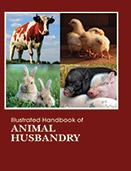Animal and Veterinary Science

The livestock sector worldwide is highly dynamic. In developing countries, it is evolving in response to rapidly increasing demand for livestock products. In developed countries, demand for livestock products is deteriorating, while many production systems are growing their efficiency and environmental sustainability. Historical changes in the demand for livestock products have been largely driven by human population growth, income growth and urbanization and the production response in different livestock systems has been associated with science and technology as well as increases in animal numbers.
Illustrated Handbook of Animal Husbandry is intended to identify and explain the causes and contributors to current problems in animal husbandry, and advance arguments that may contribute to its successful re-orientation.
Ever since the beginning of civilisation, humans have depended on animals for many requirements, such as that of food (milk, meat and egg), clothing (hide or wool), labor (pulling, carrying load) and security etc. The development of desirable qualities in all such animal species, through creating better breeds, has been an important human achievement. For this, humans have consistently tried to improve the breeds of domesticated animals to make them more useful for them. Animal health plays an important role in harnessing the expected production potential of dairy animals. A diseased animal cannot perform to the expected level. Timely intervention is therefore pivotal in reducing the economic losses due to diseases. Improvement of breeds is also the need of the hour and the farmer needs to be made aware of various aspects of breeding to be an active participant of breed improvement programmes. For making dairying a profitable and, sustainable venture, it is important for the dairy farmer to adopt scientific practices that would lead to increased productivity at optimum costs. For this to happen, the farmer should be aware of the basic tenets of animal health, breeding and feeding.
This Illustrated Handbook of Animal Husbandry is a real comprehensive integrated text to provide educational concepts and self-study guide for students, researchers, teachers, livestock extension specialists and administrators interested in the study of Animals.
Animal husbandry and dairying will receive high priority in the efforts for generating wealth and employment, increasing the availability of animal protein in the food basket and for generating exportable surpluses.